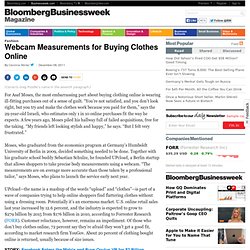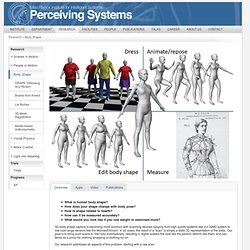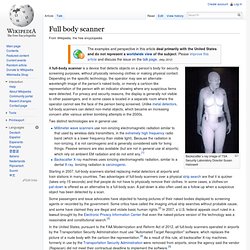

Virtual Fitting Room, The Styku Body Scanner. 3D Clothes Making - Marvelous Designer 2 (www.MarvelousDesigner.com) 3D Bodymetrics bodyscanner: Find the perfect pair of jeans without trying them on. First time Bodymetrics scanner has been used in a high street storePods take 100 measurements of customers' bodies in seven secondsAdvanced technology means compact pods will soon be found across the nation and could transform the way we shop By Deborah Arthurs Updated: 20:22 GMT, 18 October 2011 Imagine if you could find your perfect jeans without the endless trawl around denim stores trying on countless pairs.

We've all been there - wrestling on pair after pair of jeans in cramped, overheated changing rooms in an attempt to find the Holy Grail of denim - the pair that will do the impossible of slimming, lengthening and lifting. Given that it's a Herculean task to ask of any item of clothing, it's no surprise that women try on an average of 15 pairs before settling on the perfect pair... Or giving up and going home. The Bodymetric scanner takes readings from 300,000 points all over the body, creating an accurate map of the body's curves and contours. Bodymetrics virtual clothing try-on with your personal 3d fashion avatar. The Science Of Fit.
Webcam Measurements for Buying Clothes Online. For Asaf Moses, the most embarrassing part about buying clothing online is wearing ill-fitting purchases out of a sense of guilt.

“You’re not satisfied, and you don’t look right, but you try and make the clothes work because you paid for them,” says the 29-year-old Israeli, who estimates only 1 in 10 online purchases fit the way he expects. A few years ago, Moses piled his hallway full of failed acquisitions, free for the taking. “My friends left looking stylish and happy,” he says. “But I felt very frustrated.” Moses, who graduated from the economics program at Germany’s Humboldt University of Berlin in 2009, decided something needed to be done. UPcload—the name is a mashup of the words “upload” and “clothes”—is part of a wave of companies trying to help online shoppers find flattering clothes without using a dressing room.
In pursuit of the perfect fit, some companies such as eyewear manufacturer Warby Parker allow customers to upload photos and virtually try on merchandise. Www.ri.cmu.edu/pub_files/pub4/zhao_liang_2001_1/zhao_liang_2001_1.pdf. Research Theme: Body Shape. What is human body shape?

How does your shape change with body pose? How is shape related to health? How can it be measured accurately? What would you look like if you lost weight or exercised more? 3D body shape capture is becoming more common with scanning devices ranging from high quality systems like our 3dMD system to low-cost range sensors like the Microsoft Kinect. Our research addresses all aspects of this problem, starting with a raw scan. 1. Motion Recognition Clothing. Motion Recognition Clothing Medibotics' patented "Motion Recognition Clothing" technology is a novel approach to motion capture that is based on longitudinal bending of tubes that are integrated into clothing fabric that spans body joints.

Preliminary testing results suggest a modelable relationship between the change in joint angle and the change in the pressure within the tube as a joint moves and the tube is bent. Motion Recognition Clothing: Sensor Placements Planned for Next Gen 2014 Sensor Pressure as a Predictable Function of Knee Angle. Webcam Measurements for Buying Clothes Online. Full body scanner. Backscatter x-ray image of TSA Security Laboratory Director Susan Hallowell A full-body scanner is a device that detects objects on a person's body for security screening purposes, without physically removing clothes or making physical contact.

Depending on the specific technology, the operator may see an alternate-wavelength image of the person's naked body, or merely a cartoon-like representation of the person with an indicator showing where any suspicious items were detected. For privacy and security reasons, the display is generally not visible to other passengers, and in some cases is located in a separate room where the operator cannot see the face of the person being screened. Unlike metal detectors, full-body scanners can detect non-metal objects, which became an increasing concern after various airliner bombing attempts in the 2000s.
Two distinct technologies are in general use: History[edit] The first full body security scanner was developed by Dr. Usage[edit] Controversies[edit] Files.is.tue.mpg.de/black/papers/guanECCV10.pdf.